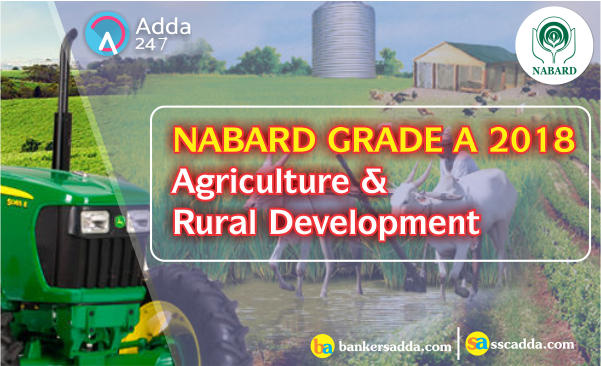
The upcoming important exams are NABARD grade A and grade B, in which there is a section Agriculture & Rural Development (with a focus on Rural India) having high weightage of 40 marks. So, for the same, it becomes really important to have an in-depth knowledge of the various terminologies and practices involved in agriculture. Further its imperative to be aware of the present scenario of Indian Agriculture and the state of Rural Development in India. To help you with this, today, we are providing you with all necessary information related to the mentioned field which will help you to fetch some good marks.
Soil Science
“The science dealing with soil as a natural resource on the surface of the earth, including Pedology (soil genesis, classification, and mapping), physical, chemical, biological and fertility properties of soil and these properties in relation to their management for crop production.”
Soil Science has six well defined and developed disciplines
Soil fertility: Nutrient supplying properties of soil
Soil chemistry: Chemical constituents, chemical properties, and the chemical reactions
Soil physics: Involves the study of physical properties
Soil microbiology: Deals with microorganisms, its population, classification, its role in transformations
Soil conservation: Dealing with protection of soil against physical loss by erosion or against chemical deterioration i.e excessive loss of nutrients either natural or artificial means.
Soil Pedology: Dealing with the genesis, survey and classification
Composition of Soil on volume basis
Mineral matter: 45%
Organic matter: 5%
Soil water: 25%
Soil air: 25%
Erosion
A process of disintegration and decomposition of rocks and minerals which are brought about by physical agents and chemical processes, leading to the formation of Regolith (unconsolidated residues of the erosion rock on the earth’s surface or above the solid rocks).
Types of erosion
There are two major types of soil erosion
a) Geological erosion (Natural or normal erosion): is said to be in equilibrium with soil forming process. It takes place under natural vegetative cover completely undisturbed by biotic factors. This is a very slow process.
b) Accelerated erosion: is due to disturbance in natural equilibrium by the activities of man and animals through land mismanagement, destructing of forests over grazing etc., Soil loss through erosion is more than the soil formed due to soil forming process.
Different agents of erosion
|
Physical/Mechanical
|
Chemical
|
Biological
|
|
1. Physical condition of rock
|
1. Hydration
|
1. Man & animals
|
|
2.Change of temperature
|
2. Hydrolysis
|
2. Higher plants & their roots
|
|
3. Action of H2O
|
3. Solution
|
3. Microorganisms
|
|
-Fragmentation & transportation
|
4. Carbonation
|
|
|
-Action of freezing
|
5. Oxidation
|
|
|
-Alternative wetting & drying
|
6. Reduction
|
|
|
-Action of glaciers
|
|
|
|
4. Action of wind
|
|
|
|
5. Atmospheric electric phenomenon
|
|
|
Forms of water erosion
Water erosion occurs in stages identified as sheet erosion, rills, gullies, ravines, landslides and stream bank erosion.
a) Sheet erosion: uniform removal of surface soil in thin layers by rainfall and runoff water. The breaking action of raindrop combined with surface flow is the major cause of sheet erosion. It is the first stage of erosion and is least conspicuous, but the most extensive.
b) Rill erosion: When runoff starts, channelization begins and erosion is no longer uniform. Raindrop impact does not directly detach any particles below flow line in rills but increases the detachment and transportation capacity of the flow. Incisions are formed on the ground due to runoff and erosion is more apparent than sheet erosion. This is the second stage of erosion. Rills are small channels, which can be removed by timely normal tillage operations.
c) Gully erosion: It is the advanced stage of water erosion. Size of the unchecked rills increases due to runoff. Gullies are formed when channelized runoff from vast sloping land is sufficient in volume and velocity to cut deep and wide channels. Gullies are the spectacular symptoms of erosion. If unchecked in time no scope for arable crop production.
d) Ravines: They are the manifestations of a prolonged process of gully erosion. They are typically found in deep alluvial soils. They are deep and wide gullies indicating advanced stage of gully erosion.
e) Landslides: Landslides occur in mountain slopes when the slope exceeds 20% and width is 6m. Generally, landslides cause blockage of traffic in ghat roads.
f) Streambank erosion: Small streams, rivulets, torrents (hill streams) are subjected to stream bank erosion due to obstruction of their flow. Vegetation sprouts when streams dry up and obstruct the flow causing cutting of bank or changing of flow course.
Mechanism of Wind Erosion
Lifting and abrasive action of wind results in detachment of tiny soil particles from the granules or clods. The impact of these rapidly moving particles dislodges other particles from clods and aggregates. In general movement of soil particles by wind takes place in three stages: saltation, surface creep, and suspension.
a) Saltation: It is the first stage of movement of soil particles in a short series of bounces or jumps along the ground surface. After being rolled by the wind, soil particles suddenly leap almost vertically to form the initial stage of movement in saltation.
b) Surface creep: Rolling and sliding of soil particles along the ground surface due to impact of particles descending and hitting during saltation is called surface creep. Movement of particles by surface creep causes an abrasive action of soil surface leading to break down of non-erodable soil aggregates.
c) Suspension: Movement of fine dust particles smaller than 0.1 mm diameter by floating in the air is known as suspension. Soil particles carried in suspension are deposited when the sedimentation force is greater than the force holding the particles in suspension. This occurs with decrease in wind velocity.
Soil conservation
Soil conservation is using and managing the land based on the capabilities of the land itself involving application of the best management practices leading to profitable crop production without land degradation.
Measures of water erosion control
a) Agronomic measures: Land preparation, Contour cultivation, Choice of crops, Strip cropping, Crop rotation /cropping systems, Cover crops, Mulching, Application of manures and fertilizers, Application of chemicals
b) Mechanical measures (Engineering measures): involve construction of mechanical barriers across the direction of flow of rainwater to retard or retain runoff and thereby reduce soil and water loss. The mechanical measures include: Contour bunding; Graded bunding; Bench terracing; Gully control /plugging; Vegetative barriers
c) Forestry measures: Forest lands are usually found at higher elevations where the slopes are steepest, soils are less stable and easily eroded and precipitation is heavy. The leaves and branches of trees and shrubs intercept the rain and reduce the impact of raindrops. Contour trenching and aforestation is recommended for improving the productivity of forests.
d) Agrostological measures: Grasses prevent erosion by intercepting rainfall and by their binding power of the soil particles. The desirable characters of grasses for soil conservation are: Should be perennial; Drought resistant; Rhizomniferous; Develop good canopy; Deep root system; Prostate growth habit; Less palatable to cattle; Useful for cottage industries
Watershed Management
A watershed is defined as any spatial area from which runoff from precipitation is collected and drained through a common point or outlet. In other words, it is a land surface bounded by a divide, which contributes runoff to a common point. It is defined as unit of area, which covers all the land, which contributes runoff to a common point. It is synonymous with a drainage basin or catchment area. The basic unit of development is a watershed, which is a manageable hydrological unit.
Watershed management is the rational utilization of land and water resources for optimum production with minimum hazard to natural resources.
Watershed management has been taken up under different programmes launched by Government of India. The Drought Prone Area Development Programme (DPAP) and the Desert Development Programme (DDP) adopted watershed development approach in 1987. The Integrated Watershed Development Project (IWDP) taken up by the National Wasteland Development Board (NWDB) in 1989 also aimed at the development of wastelands on watershed basis. The fourth major programme based on watershed concept is the National Watershed Development Programme for Rainfed Areas (NWDPRA) under the Ministry of Agriculture.The ministry of Rural development funds watershed development schemes under DDP, DPAP, and IWDP.
The main components of watershed programme are:
1. Soil and water conservation
2. Water harvesting
3. Crop management and
4. Alternate land use systems
Based on the size the watersheds may be classified as
Micro watersheds: The size of the watershed range from few hectares to hundreds of hectares. These can be designed within the crop fields.
Small watersheds: The watershed has few thousands of hectares as drainage area.
Large watersheds: The river basins are considered as large watersheds.
The objectives of watershed management programme can also be described in symbolic form by the expression: POWER. Here the letters symbolize the following:
P= Production of food-fodder-fuel-fruit-fibre-fish-milk combined on a sustained basis- Pollution control; Prevention of floods
O= Over-exploitation of resources to be minimized by controlling excessive biotic interferences like overgrazing- Operational practicability of all on farm operations and follow-up programmes including easy approachability to different locations in watershed
W= Water storage at convenient locations for different purposes- Wild animal and indigenous plant life conservation at selected places
E= Erosion control- Ecosystem safety; Economic stability; Employment generation
R= Recharge of groundwater- Reduction of drought hazards; Reduction of siltation in multipurpose reservoirs; Recreation
You may also like to Read:



 The Hindu Review October 2022: Download ...
The Hindu Review October 2022: Download ...
 SBI SO Salary 2024, Salary Structure, Pe...
SBI SO Salary 2024, Salary Structure, Pe...
 SBI Clerk Previous Year Question Paper P...
SBI Clerk Previous Year Question Paper P...



